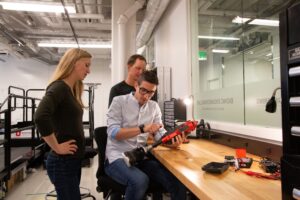 TIME’s annual list of the Best Inventions features 200 extraordinary innovations with the capacity to change people’s lives. To compile the list, TIME’s editors solicit nominations and accept applications describing groundbreaking work in key fields —such as AI, green energy, and sustainability — evaluating each contender on a number factors, including originality, efficacy, ambition, and impact.
TIME’s annual list of the Best Inventions features 200 extraordinary innovations with the capacity to change people’s lives. To compile the list, TIME’s editors solicit nominations and accept applications describing groundbreaking work in key fields —such as AI, green energy, and sustainability — evaluating each contender on a number factors, including originality, efficacy, ambition, and impact.
This year, TIME has selected the Utah Bionic Leg as one of the best inventions of 2023, naming it in its “Experimental” category.
With its suite of motors, sensors, and controllers, the robotic prosthesis can better replicate the biomechanics of the human knee, ankle, and toe, giving it the potential to improve the mobility and quality-of-life of millions of people living with amputation worldwide.
The Utah Bionic Leg was developed by Tommaso Lenzi, associate professor in the Department of Mechanical Engineering, and his students in the HGN Lab for Bionic Engineering.
“The ‘passive’ joints in traditional prostheses can’t fully replicate the biomechanical functions of a biological leg,” Lenzi says. “This makes walking substantially harder, especially on inclines or when climbing stairs. It also leads to users compensating for their prostheses’ deficiencies with other parts of their bodies, which can cause secondary complications, such as back pain and osteoarthritis.”
 While motorized leg prostheses have existed for more than 30 years, none have achieved significant clinical impact; users have found them to be too heavy and inefficient to be worn every day.
While motorized leg prostheses have existed for more than 30 years, none have achieved significant clinical impact; users have found them to be too heavy and inefficient to be worn every day.
Lenzi and his colleagues’ breakthrough in actuation technology allowed them to achieve power and torque densities that were previously impossible. Thanks to a lightweight, variable transmission, the Utah Bionic Leg replicates the full range of speed and torque of the human knee with smaller motors and batteries than previous powered prostheses. An artificial tendon that connects the toe and ankle joints also regenerates mechanical energy, allowing the Utah Bionic leg to provide more power despite its lighter weight.
The Utah Bionic Leg was previously featured on the cover of the journal Science Robotics, highlighting the study in which Lenzi and his colleagues demonstrated the biomechanics of its knee, ankle, and toe joints.
Read more about the Utah Bionic Leg and other Best Inventions of 2023 at TIME.

